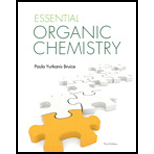
(a)
Interpretation:
The configuration of the given structure of citric acid has to be determined.
Concept introduction:
According to Cahn-Ingold-Prelog system,
The group attached to asymmetric center should be ranked based on the
Check the direction of arrow drawn in the direction of decreasing priority. If the arrow points clockwise direction, then the compound has R configuration. If the arrow points counterclockwise direction, then the compound has S configuration. If the group with lowest priority is not bonded by a hatched wedge, then interchange this group (lowest priority) by group bonded to hatched wedge and draw the arrow in priority order but the configuration is assigned as just reverse.
(b)
Interpretation:
The chirality of citric acid if
Concept introduction:
Optical activity of a molecule is the interaction between molecule and plane-polarized light.
Molecule having asymmetric center shows optical activity except mesocompounds.
Asymmetric center is a stereocenter which arises to hydrocarbons if the carbon is bonded to four different groups.
Want to see the full answer?
Check out a sample textbook solution
Chapter 4 Solutions
Pearson eText for Essential Organic Chemistry -- Instant Access (Pearson+)
- When ethylamine, a weak base (Kb=4.3104) , reacts with formic acid, a weak acid (Ka=1.8104) , the following reaction takes place: CH3CH2NH2(aq)+HCOOH(aq)CH3CH2NH3+(aq)+HCOO(aq) Calculate K for this reaction.arrow_forwardCatalytic cracking is an industrial process used to convert high-molecular-weight hydrocarbons to low-molecular-weight hydrocarbons. A petroleum company has a huge supply of heating oil stored as straight-chain C17H36, and demand has picked up for shorter chain hydrocarbons to be used in formulating gasoline. The company uses catalytic cracking to create the shorter chains necessary for gasoline. If they produce two molecules in the cracking, and 1-octene is one of them, what is the formula of the other molecule produced? As part of your answer, draw the condensed structural formula of the 1-octene.arrow_forwardDefine Alicyclicarrow_forward
- The structural formula for the open-chain form of D-mannose is CH НО—С—Н Но-с—н Н—С—ОН Н—ҫ—ОН CH-OН (a) Is this molecule a sugar? (b) How many chiral carbons are present in the molecule? (c) Draw the structure of the six-member-ring form of this molecule.arrow_forwardThe structure of DNA is based on a sugar, deoxyribose, shown below: OH НО Но 2-deoxyribose The cyclic form of deoxyribose contains • stereocentres. The open-chain form of deoxyribose has : stereocentres.arrow_forward1) LiAlH, in Et₂O 2) H₂O*arrow_forward
- One pathway for the metabolism of D-glucose 6-phosphate is its enzyme-catalyzed conversion to D-fructose 6-phosphate. Show that this transformation can be accom- plished as two enzyme-catalyzed keto-enol tautomerisms. СНО CH,OH C=0 enzyme catalysis Но Но H OH H H. O- H- -HO- ČH,OPO, ČH,OPO, D-Glucose 6-phosphate D-Fructose 6-phosphatearrow_forwardWhen HOCH2CH2CH2CH2COCH2CH2CH2CH2OH is heated in the presence of an acid catalyst, a reaction occurs. This product has the formula C9H16)2. Provide the structure of this product.arrow_forward119. Subject :- Chemistryarrow_forward
- Write structural formulas for the products formed in each of the following reactions, and categorize the type of reaction involved (a) CH3CH2CHO + (O) → (b) CH3CH=CH2 + HBr →arrow_forwardWhich is the product for these reactions:arrow_forwardDraw the product of the following compounds with the given image.arrow_forward
 Chemistry: The Molecular ScienceChemistryISBN:9781285199047Author:John W. Moore, Conrad L. StanitskiPublisher:Cengage LearningChemistry: Matter and ChangeChemistryISBN:9780078746376Author:Dinah Zike, Laurel Dingrando, Nicholas Hainen, Cheryl WistromPublisher:Glencoe/McGraw-Hill School Pub Co
Chemistry: The Molecular ScienceChemistryISBN:9781285199047Author:John W. Moore, Conrad L. StanitskiPublisher:Cengage LearningChemistry: Matter and ChangeChemistryISBN:9780078746376Author:Dinah Zike, Laurel Dingrando, Nicholas Hainen, Cheryl WistromPublisher:Glencoe/McGraw-Hill School Pub Co Organic ChemistryChemistryISBN:9781305580350Author:William H. Brown, Brent L. Iverson, Eric Anslyn, Christopher S. FootePublisher:Cengage Learning
Organic ChemistryChemistryISBN:9781305580350Author:William H. Brown, Brent L. Iverson, Eric Anslyn, Christopher S. FootePublisher:Cengage Learning ChemistryChemistryISBN:9781305957404Author:Steven S. Zumdahl, Susan A. Zumdahl, Donald J. DeCostePublisher:Cengage Learning
ChemistryChemistryISBN:9781305957404Author:Steven S. Zumdahl, Susan A. Zumdahl, Donald J. DeCostePublisher:Cengage Learning Chemistry: An Atoms First ApproachChemistryISBN:9781305079243Author:Steven S. Zumdahl, Susan A. ZumdahlPublisher:Cengage Learning
Chemistry: An Atoms First ApproachChemistryISBN:9781305079243Author:Steven S. Zumdahl, Susan A. ZumdahlPublisher:Cengage Learning





